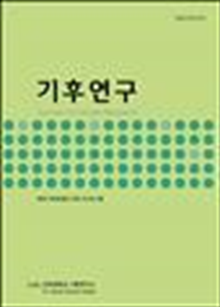간행물
기후연구 KCI 등재 Journal of Climate Research

- 발행기관 건국대학교 기후연구소
- 자료유형 학술지
- 간기 계간
- ISSN 1975-6151 (Print)2288-8772 (Online)
- 수록기간 2006 ~ 2021
- 주제분류 사회과학 > 지리학 사회과학 분류의 다른 간행물
- 십진분류KDC 453DDC 551
권호리스트/논문검색
제14권 제3호 (2019년 9월) 4건
1.
2019.09
서비스 종료(열람 제한)
The objective of the current study is to investigate and evaluate the annual and seasonal rainfall trends and patterns of the Punjab province, Pakistan during the 1981-2015. The spatial patterns and temporal trends were identified through the Modified Mann Kendall test. Finding revealed that 13 weather stations of Punjab province have shown the statistically significant decreasing trend of annual and summer monsoon rainfall during the study period. From further investigation, the rainfall during the summer monsoon period (JJAS) found to be increased by 12.45%, similarly the rainfall during the whole of year be also increased by 18.75%. The significant decreasing trends observed with the higher percentage change in annual and monsoon rainfall for the stations of Sialkot and Lahore in the northern and central Punjab. The empirical evidences suggested that northern Punjab gets more moisture as compared the Southern and Western Punjab. This study suggests intensive empirical research in the future to evolve further spatio-temporal trends in the rainfall pattern of Punjab.
2.
2019.09
서비스 종료(열람 제한)
Climate change affects the occurrence of heat waves in Korea. Heat wave gives significant impacts not only to human health, but also adversely affects on traffic accidents both directly and indirectly. This study analyzed heat wave impacts on traffic accidents in summer time (JJA) from 2012 to 2017 timely. To consider some occupations work in earlier or later than regular working hour, 04~20h is set for this study. Generalized additive model is used to analyze the relation between the temperature and traffic accidents. The results showed that the traffic accidents in high temperature increases in 04~08h, 08~12h, and especially 18~20h. The percent difference for relative risk of traffic accidents is 2.34% (95% confidence interval: 1.140, 3.269) when the temperature increase by 1°C in 18~20h. The results of this study suggest some requirements for measures to prevent traffic accidents in the morning and evening hours with increasing temperatures.
3.
2019.09
서비스 종료(열람 제한)
Water resources planning and management are, more and more, becoming important issue for water use and flood control due to the population increase, urbanization, and climate change. In particular, the estimating and the forecasting inflow of dam is the most important hydrologic issue for flood control and reliable water supply. Therefore, this study forecasted monthly inflow of Soyang river dam using VARMA model and 3 machine learning models. The forecasting models were constructed using monthly inflow data in the period of 1974 to 2016 and then the inflows were forecasted at 12- and 24-month ahead lead times. As a result, the forecasted monthly inflows by the models mostly were less than the observed ones, but the peak time and the variation pattern were well forecasted. Especially, the VARMA model showed very good performance in the forecasting. Therefore, the result of this study indicates that the VARMA model can be used efficiently to forecast hydrologic data and also used to establish water supply and management plan.
4.
2019.09
서비스 종료(열람 제한)
Ensemble verification and prediction of low-level wind shear (LLWS) are an important matter for airplane landing and management. In this study, we compared the prediction performance of LLWS forecasts of ensemble mean, multiple regression model and long short-term memory (LSTM), which belong to the family of recurrent neural network based on the grid points over the Jeju area. The prediction skills of methods were compared by mean absolute error. We found that the prediction skills of forecasts of LSTM were better than the bias-corrected forecasts in terms of deterministic prediction.

